Gaojie Chen
Joint Beamforming and Position Optimization for Fluid STAR-RIS-NOMA Assisted Wireless Communication Systems
Jul 09, 2025Abstract:To address the limitations of traditional reconfigurable intelligent surfaces (RIS) in spatial control capability, this paper introduces the concept of the fluid antenna system (FAS) and proposes a fluid simultaneously transmitting and reflecting RIS (FSTAR-RIS) assisted non-orthogonal multiple access (NOMA) multi-user communication system. In this system, each FSTAR-RIS element is capable of flexible mobility and can dynamically adjust its position in response to environmental variations, thereby enabling simultaneous service to users in both the transmission and reflection zones. This significantly enhances the system's spatial degrees of freedom (DoF) and service adaptability. To maximize the system's weighted sum-rate, we formulate a non-convex optimization problem that jointly optimizes the base station beamforming, the transmission/reflection coefficients of the FSTAR-RIS, and the element positions. An alternating optimization (AO) algorithm is developed, incorporating successive convex approximation (SCA), semi-definite relaxation (SDR), and majorization-minimization (MM) techniques. In particular, to address the complex channel coupling introduced by the coexistence of direct and FSTAR-RIS paths, the MM framework is employed in the element position optimization subproblem, enabling an efficient iterative solution strategy. Simulation results validate that the proposed system achieves up to a 27% increase in total sum rate compared to traditional STAR-RIS systems and requires approximately 50% fewer RIS elements to attain the same performance, highlighting its effectiveness for cost-efficient large-scale deployment.
Widely Linear Augmented Extreme Learning Machine Based Impairments Compensation for Satellite Communications
Jun 17, 2025Abstract:Satellite communications are crucial for the evolution beyond fifth-generation networks. However, the dynamic nature of satellite channels and their inherent impairments present significant challenges. In this paper, a novel post-compensation scheme that combines the complex-valued extreme learning machine with augmented hidden layer (CELMAH) architecture and widely linear processing (WLP) is developed to address these issues by exploiting signal impropriety in satellite communications. Although CELMAH shares structural similarities with WLP, it employs a different core algorithm and does not fully exploit the signal impropriety. By incorporating WLP principles, we derive a tailored formulation suited to the network structure and propose the CELM augmented by widely linear least squares (CELM-WLLS) for post-distortion. The proposed approach offers enhanced communication robustness and is highly effective for satellite communication scenarios characterized by dynamic channel conditions and non-linear impairments. CELM-WLLS is designed to improve signal recovery performance and outperform traditional methods such as least square (LS) and minimum mean square error (MMSE). Compared to CELMAH, CELM-WLLS demonstrates approximately 0.8 dB gain in BER performance, and also achieves a two-thirds reduction in computational complexity, making it a more efficient solution.
Model Splitting Enhanced Communication-Efficient Federated Learning for CSI Feedback
Jun 04, 2025Abstract:Recent advancements have introduced federated machine learning-based channel state information (CSI) compression before the user equipments (UEs) upload the downlink CSI to the base transceiver station (BTS). However, most existing algorithms impose a high communication overhead due to frequent parameter exchanges between UEs and BTS. In this work, we propose a model splitting approach with a shared model at the BTS and multiple local models at the UEs to reduce communication overhead. Moreover, we implant a pipeline module at the BTS to reduce training time. By limiting exchanges of boundary parameters during forward and backward passes, our algorithm can significantly reduce the exchanged parameters over the benchmarks during federated CSI feedback training.
MmWave-LoRadar Empowered Vehicular Integrated Sensing and Communication Systems: LoRa Meets FMCW
May 16, 2025Abstract:The integrated sensing and communication (ISAC) technique is regarded as a key component in future vehicular applications. In this paper, we propose an ISAC solution that integrates Long Range (LoRa) modulation with frequency-modulated continuous wave (FMCW) radar in the millimeter-wave (mmWave) band, called mmWave-LoRadar. This design introduces the sensing capabilities to the LoRa communication with a simplified hardware architecture. Particularly, we uncover the dual discontinuity issues in time and phase of the mmWave-LoRadar received signals, rendering conventional signal processing techniques ineffective. As a remedy, we propose a corresponding hardware design and signal processing schemes under the compressed sampling framework. These techniques effectively cope with the dual discontinuity issues and mitigate the demands for high-sampling-rate analog-to-digital converters while achieving good performance. Simulation results demonstrate the superiority of the mmWave-LoRadar ISAC system in vehicular communication and sensing networks.
The Communication and Computation Trade-off in Wireless Semantic Communications
Apr 14, 2025
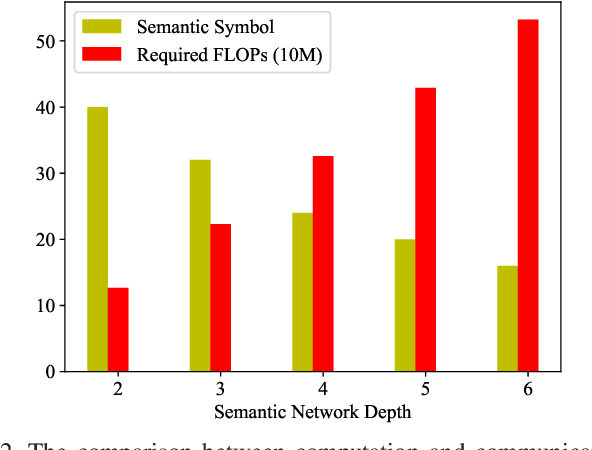
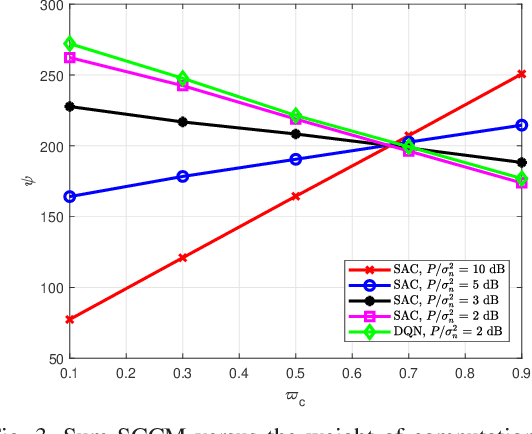
Abstract:Semantic communications have emerged as a crucial research direction for future wireless communication networks. However, as wireless systems become increasingly complex, the demands for computation and communication resources in semantic communications continue to grow rapidly. This paper investigates the trade-off between computation and communication in wireless semantic communications, taking into consideration transmission task delay and performance constraints within the semantic communication framework. We propose a novel tradeoff metric to analyze the balance between computation and communication in semantic transmissions and employ the deep reinforcement learning (DRL) algorithm to minimize this metric, thereby reducing the cost associated with balancing computation and communication. Through simulations, we analyze the tradeoff between computation and communication and demonstrate the effectiveness of optimizing this trade-off metric.
Amplitude-Domain Reflection Modulation for Active RIS-Assisted Wireless Communications
Mar 27, 2025Abstract:In this paper, we propose a novel active reconfigurable intelligent surface (RIS)-assisted amplitude-domain reflection modulation (ADRM) transmission scheme, termed as ARIS-ADRM. This innovative approach leverages the additional degree of freedom (DoF) provided by the amplitude domain of the active RIS to perform index modulation (IM), thereby enhancing spectral efficiency (SE) without increasing the costs associated with additional radio frequency (RF) chains. Specifically, the ARIS-ADRM scheme transmits information bits through both the modulation symbol and the index of active RIS amplitude allocation patterns (AAPs). To evaluate the performance of the proposed ARIS-ADRM scheme, we provide an achievable rate analysis and derive a closed-form expression for the upper bound on the average bit error probability (ABEP). Furthermore, we formulate an optimization problem to construct the AAP codebook, aiming to minimize the ABEP. Simulation results demonstrate that the proposed scheme significantly improves error performance under the same SE conditions compared to its benchmarks. This improvement is due to its ability to flexibly adapt the transmission rate by fully exploiting the amplitude domain DoF provided by the active RIS.
Joint Sparse Graph for Enhanced MIMO-AFDM Receiver Design
Mar 24, 2025Abstract:Affine frequency division multiplexing (AFDM) is a promising chirp-assisted multicarrier waveform for future high-mobility communications. This paper is devoted to enhanced receiver design for multiple input and multiple output AFDM (MIMO-AFDM) systems. Firstly, we introduce a unified variational inference (VI) approach to approximate the target posterior distribution, under which the belief propagation (BP) and expectation propagation (EP)-based algorithms are derived. As both VI-based detection and low-density parity-check (LDPC) decoding can be expressed by bipartite graphs in MIMO-AFDM systems, we construct a joint sparse graph (JSG) by merging the graphs of these two for low-complexity receiver design. Then, based on this graph model, we present the detailed message propagation of the proposed JSG. Additionally, we propose an enhanced JSG (E-JSG) receiver based on the linear constellation encoding model. The proposed E-JSG eliminates the need for interleavers, de-interleavers, and log-likelihood ratio transformations, thus leading to concurrent detection and decoding over the integrated sparse graph. To further reduce detection complexity, we introduce a sparse channel method by approaximating multiple graph edges with insignificant channel coefficients into a single edge on the VI graph. Simulation results show the superiority of the proposed receivers in terms of computational complexity, detection and decoding latency, and error rate performance compared to the conventional ones.
Single Sparse Graph Enhanced Expectation Propagation Algorithm Design for Uplink MIMO-SCMA
Mar 17, 2025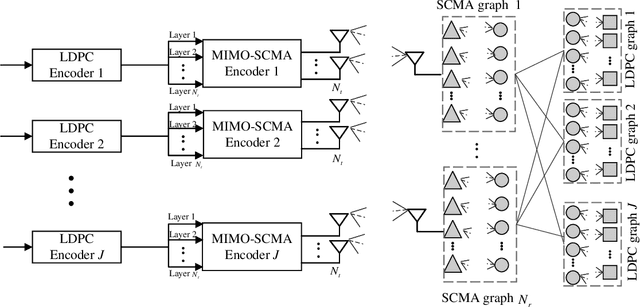
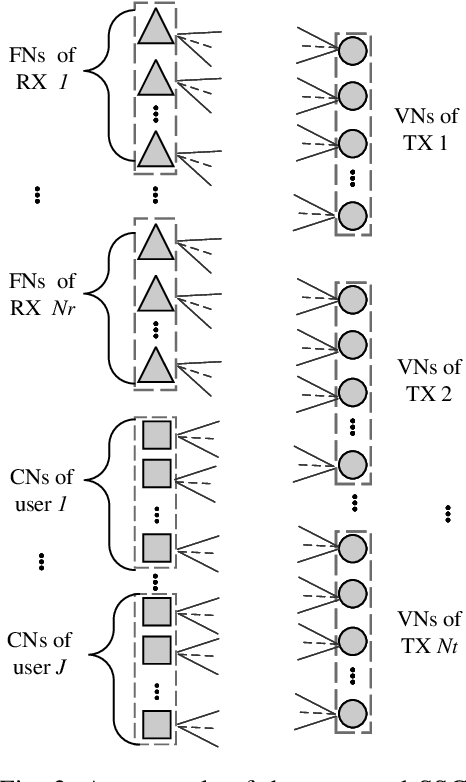
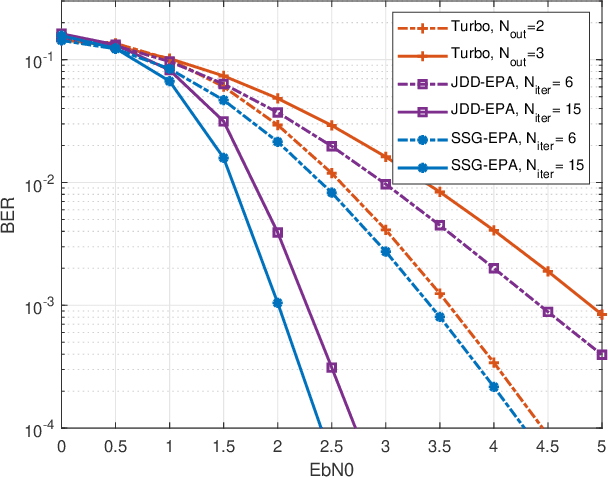
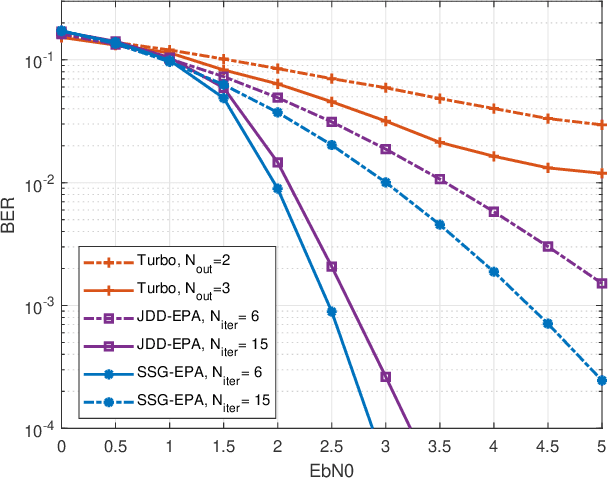
Abstract:Sparse code multiple access (SCMA) and multiple input multiple output (MIMO) are considered as two efficient techniques to provide both massive connectivity and high spectrum efficiency for future machine-type wireless networks. This paper proposes a single sparse graph (SSG) enhanced expectation propagation algorithm (EPA) receiver, referred to as SSG-EPA, for uplink MIMO-SCMA systems. Firstly, we reformulate the sparse codebook mapping process using a linear encoding model, which transforms the variable nodes (VNs) of SCMA from symbol-level to bit-level VNs. Such transformation facilitates the integration of the VNs of SCMA and low-density parity-check (LDPC), thereby emerging the SCMA and LDPC graphs into a SSG. Subsequently, to further reduce the detection complexity, the message propagation between SCMA VNs and function nodes (FNs) are designed based on EPA principles. Different from the existing iterative detection and decoding (IDD) structure, the proposed EPA-SSG allows a simultaneously detection and decoding at each iteration, and eliminates the use of interleavers, de-interleavers, symbol-to-bit, and bit-to-symbol LLR transformations. Simulation results show that the proposed SSG-EPA achieves better error rate performance compared to the state-of-the-art schemes.
Affine Frequency Division Multiplexing: Extending OFDM for Scenario-Flexibility and Resilience
Feb 07, 2025



Abstract:Next-generation wireless networks are conceived to provide reliable and high-data-rate communication services for diverse scenarios, such as vehicle-to-vehicle, unmanned aerial vehicles, and satellite networks. The severe Doppler spreads in the underlying time-varying channels induce destructive inter-carrier interference (ICI) in the extensively adopted orthogonal frequency division multiplexing (OFDM) waveform, leading to severe performance degradation. This calls for a new air interface design that can accommodate the severe delay-Doppler spreads in highly dynamic channels while possessing sufficient flexibility to cater to various applications. This article provides a comprehensive overview of a promising chirp-based waveform named affine frequency division multiplexing (AFDM). It is featured with two tunable parameters and achieves optimal diversity order in doubly dispersive channels (DDC). We study the fundamental principle of AFDM, illustrating its intrinsic suitability for DDC. Based on that, several potential applications of AFDM are explored. Furthermore, the major challenges and the corresponding solutions of AFDM are presented, followed by several future research directions. Finally, we draw some instructive conclusions about AFDM, hoping to provide useful inspiration for its development.
Direct Uplink Connectivity in Space MIMO Systems with THz and FSO Inter-Satellite Links
Feb 02, 2025Abstract:This paper investigates uplink transmission from a single-antenna mobile phone to a cluster of satellites, emphasizing the role of inter-satellite links (ISLs) in facilitating cooperative signal detection. The study focuses on non-ideal ISLs, examining both terahertz (THz) and free-space optical (FSO) ISLs concerning their ergodic capacity. We present a practical scenario derived from the recent 3GPP standard, specifying the frequency band, bandwidth, user and satellite antenna gains, power levels, and channel characteristics in alignment with the latest 3GPP for non-terrestrial networks (NTN). Additionally, we propose a satellite selection method to identify the optimal satellite as the master node (MN), responsible for signal processing. This method takes into account both the user-satellite link and ISL channels. For the THz ISL analysis, we derive a closed-form approximation for ergodic capacity under two scenarios: one with instantaneous channel state information (CSI) and another with only statistical CSI shared between satellites. For the FSO ISL analysis, we present a closed-form approximate upper bound for ergodic capacity, accounting for the impact of pointing error loss. Furthermore, we evaluate the effects of different ISL frequencies and pointing errors on spectral efficiency. Simulation results demonstrate that multi-satellite multiple-input multiple-output (MIMO) satellite communication (SatCom) significantly outperforms single-satellite SatCom in terms of spectral efficiency. Additionally, our approximated upper bound for ergodic capacity closely aligns with results obtained from Monte Carlo simulations.
 Add to Chrome
Add to Chrome Add to Firefox
Add to Firefox Add to Edge
Add to Edge